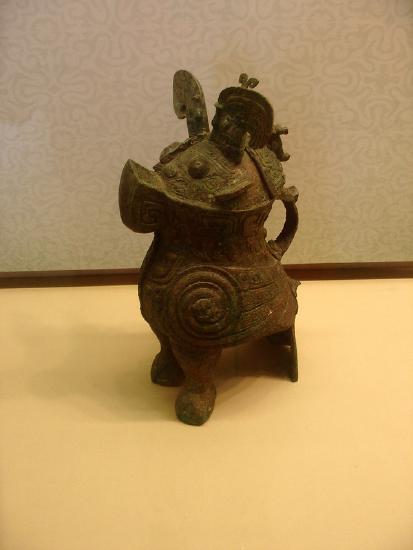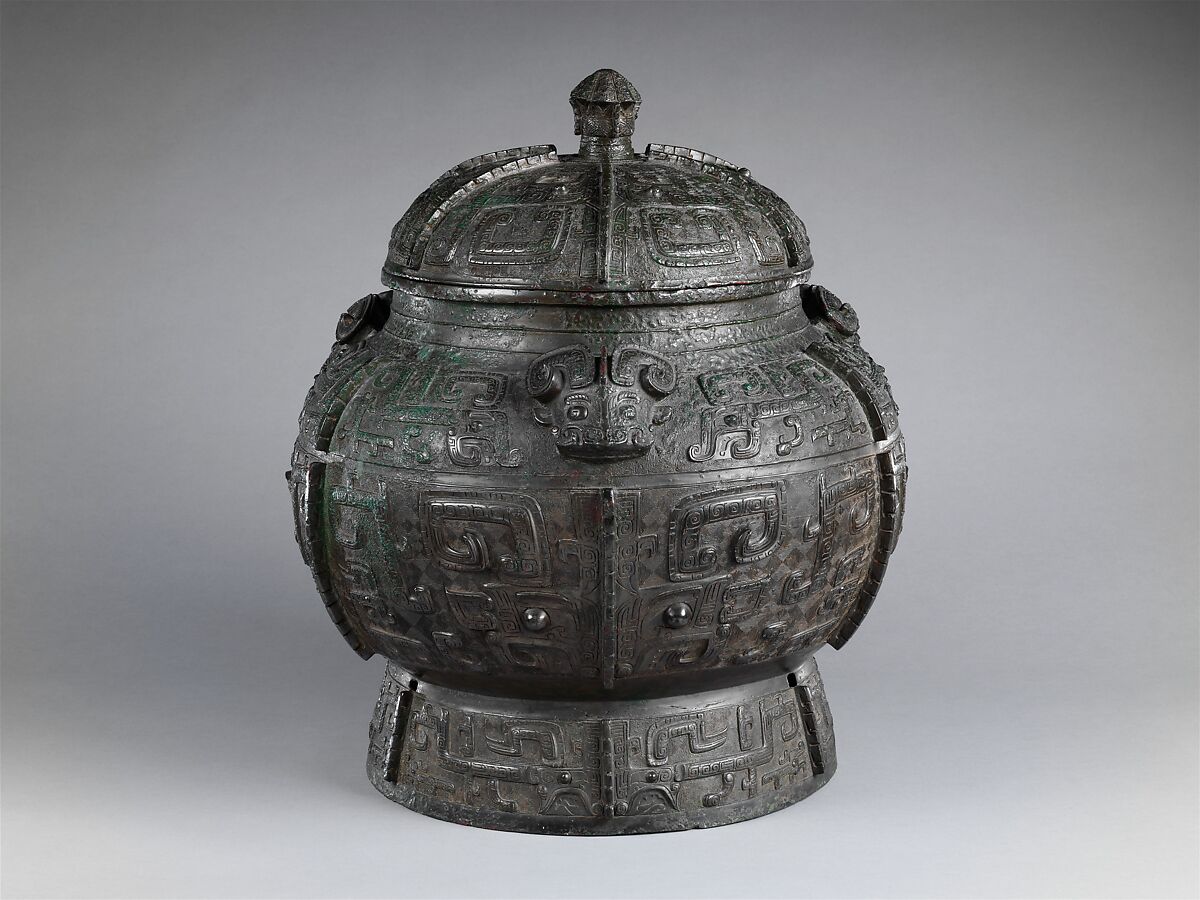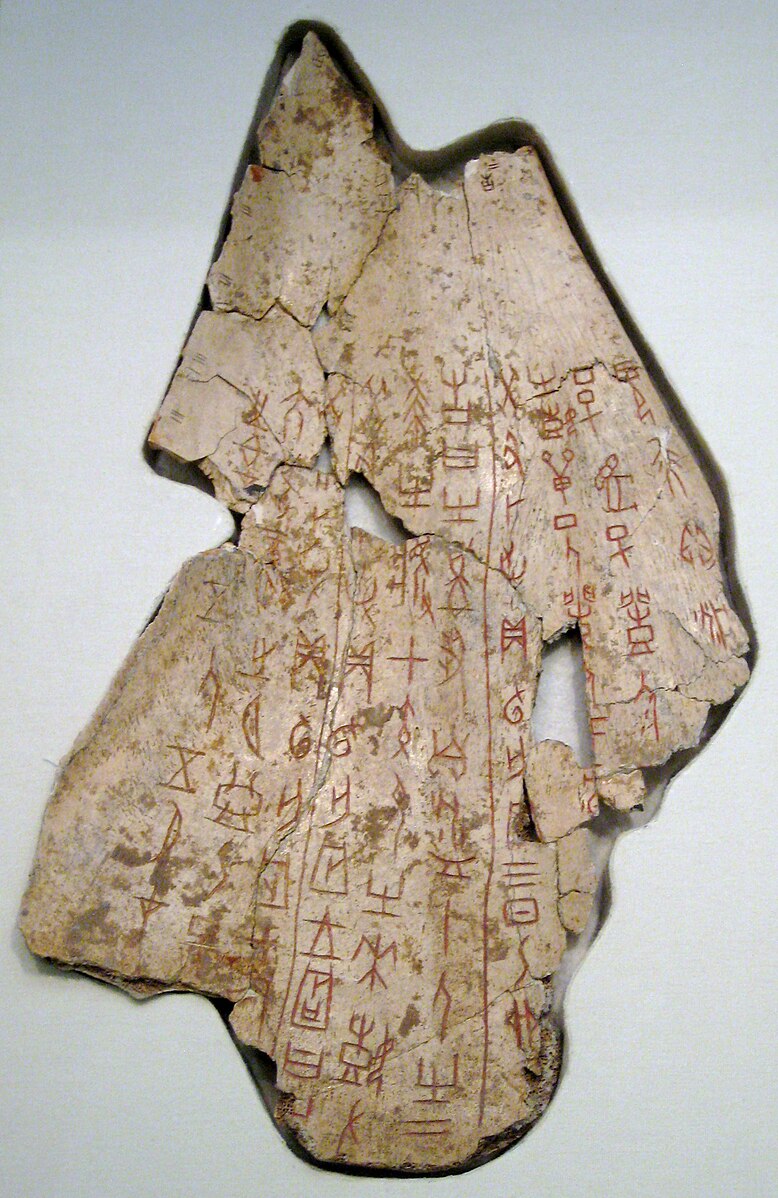3.3: Bronze Age - Shang Dynasty (1600 BCE – 1046 BCE)
- Page ID
- 219966
\( \newcommand{\vecs}[1]{\overset { \scriptstyle \rightharpoonup} {\mathbf{#1}} } \)
\( \newcommand{\vecd}[1]{\overset{-\!-\!\rightharpoonup}{\vphantom{a}\smash {#1}}} \)
\( \newcommand{\id}{\mathrm{id}}\) \( \newcommand{\Span}{\mathrm{span}}\)
( \newcommand{\kernel}{\mathrm{null}\,}\) \( \newcommand{\range}{\mathrm{range}\,}\)
\( \newcommand{\RealPart}{\mathrm{Re}}\) \( \newcommand{\ImaginaryPart}{\mathrm{Im}}\)
\( \newcommand{\Argument}{\mathrm{Arg}}\) \( \newcommand{\norm}[1]{\| #1 \|}\)
\( \newcommand{\inner}[2]{\langle #1, #2 \rangle}\)
\( \newcommand{\Span}{\mathrm{span}}\)
\( \newcommand{\id}{\mathrm{id}}\)
\( \newcommand{\Span}{\mathrm{span}}\)
\( \newcommand{\kernel}{\mathrm{null}\,}\)
\( \newcommand{\range}{\mathrm{range}\,}\)
\( \newcommand{\RealPart}{\mathrm{Re}}\)
\( \newcommand{\ImaginaryPart}{\mathrm{Im}}\)
\( \newcommand{\Argument}{\mathrm{Arg}}\)
\( \newcommand{\norm}[1]{\| #1 \|}\)
\( \newcommand{\inner}[2]{\langle #1, #2 \rangle}\)
\( \newcommand{\Span}{\mathrm{span}}\) \( \newcommand{\AA}{\unicode[.8,0]{x212B}}\)
\( \newcommand{\vectorA}[1]{\vec{#1}} % arrow\)
\( \newcommand{\vectorAt}[1]{\vec{\text{#1}}} % arrow\)
\( \newcommand{\vectorB}[1]{\overset { \scriptstyle \rightharpoonup} {\mathbf{#1}} } \)
\( \newcommand{\vectorC}[1]{\textbf{#1}} \)
\( \newcommand{\vectorD}[1]{\overrightarrow{#1}} \)
\( \newcommand{\vectorDt}[1]{\overrightarrow{\text{#1}}} \)
\( \newcommand{\vectE}[1]{\overset{-\!-\!\rightharpoonup}{\vphantom{a}\smash{\mathbf {#1}}}} \)
\( \newcommand{\vecs}[1]{\overset { \scriptstyle \rightharpoonup} {\mathbf{#1}} } \)
\( \newcommand{\vecd}[1]{\overset{-\!-\!\rightharpoonup}{\vphantom{a}\smash {#1}}} \)
\(\newcommand{\avec}{\mathbf a}\) \(\newcommand{\bvec}{\mathbf b}\) \(\newcommand{\cvec}{\mathbf c}\) \(\newcommand{\dvec}{\mathbf d}\) \(\newcommand{\dtil}{\widetilde{\mathbf d}}\) \(\newcommand{\evec}{\mathbf e}\) \(\newcommand{\fvec}{\mathbf f}\) \(\newcommand{\nvec}{\mathbf n}\) \(\newcommand{\pvec}{\mathbf p}\) \(\newcommand{\qvec}{\mathbf q}\) \(\newcommand{\svec}{\mathbf s}\) \(\newcommand{\tvec}{\mathbf t}\) \(\newcommand{\uvec}{\mathbf u}\) \(\newcommand{\vvec}{\mathbf v}\) \(\newcommand{\wvec}{\mathbf w}\) \(\newcommand{\xvec}{\mathbf x}\) \(\newcommand{\yvec}{\mathbf y}\) \(\newcommand{\zvec}{\mathbf z}\) \(\newcommand{\rvec}{\mathbf r}\) \(\newcommand{\mvec}{\mathbf m}\) \(\newcommand{\zerovec}{\mathbf 0}\) \(\newcommand{\onevec}{\mathbf 1}\) \(\newcommand{\real}{\mathbb R}\) \(\newcommand{\twovec}[2]{\left[\begin{array}{r}#1 \\ #2 \end{array}\right]}\) \(\newcommand{\ctwovec}[2]{\left[\begin{array}{c}#1 \\ #2 \end{array}\right]}\) \(\newcommand{\threevec}[3]{\left[\begin{array}{r}#1 \\ #2 \\ #3 \end{array}\right]}\) \(\newcommand{\cthreevec}[3]{\left[\begin{array}{c}#1 \\ #2 \\ #3 \end{array}\right]}\) \(\newcommand{\fourvec}[4]{\left[\begin{array}{r}#1 \\ #2 \\ #3 \\ #4 \end{array}\right]}\) \(\newcommand{\cfourvec}[4]{\left[\begin{array}{c}#1 \\ #2 \\ #3 \\ #4 \end{array}\right]}\) \(\newcommand{\fivevec}[5]{\left[\begin{array}{r}#1 \\ #2 \\ #3 \\ #4 \\ #5 \\ \end{array}\right]}\) \(\newcommand{\cfivevec}[5]{\left[\begin{array}{c}#1 \\ #2 \\ #3 \\ #4 \\ #5 \\ \end{array}\right]}\) \(\newcommand{\mattwo}[4]{\left[\begin{array}{rr}#1 \amp #2 \\ #3 \amp #4 \\ \end{array}\right]}\) \(\newcommand{\laspan}[1]{\text{Span}\{#1\}}\) \(\newcommand{\bcal}{\cal B}\) \(\newcommand{\ccal}{\cal C}\) \(\newcommand{\scal}{\cal S}\) \(\newcommand{\wcal}{\cal W}\) \(\newcommand{\ecal}{\cal E}\) \(\newcommand{\coords}[2]{\left\{#1\right\}_{#2}}\) \(\newcommand{\gray}[1]{\color{gray}{#1}}\) \(\newcommand{\lgray}[1]{\color{lightgray}{#1}}\) \(\newcommand{\rank}{\operatorname{rank}}\) \(\newcommand{\row}{\text{Row}}\) \(\newcommand{\col}{\text{Col}}\) \(\renewcommand{\row}{\text{Row}}\) \(\newcommand{\nul}{\text{Nul}}\) \(\newcommand{\var}{\text{Var}}\) \(\newcommand{\corr}{\text{corr}}\) \(\newcommand{\len}[1]{\left|#1\right|}\) \(\newcommand{\bbar}{\overline{\bvec}}\) \(\newcommand{\bhat}{\widehat{\bvec}}\) \(\newcommand{\bperp}{\bvec^\perp}\) \(\newcommand{\xhat}{\widehat{\xvec}}\) \(\newcommand{\vhat}{\widehat{\vvec}}\) \(\newcommand{\uhat}{\widehat{\uvec}}\) \(\newcommand{\what}{\widehat{\wvec}}\) \(\newcommand{\Sighat}{\widehat{\Sigma}}\) \(\newcommand{\lt}{<}\) \(\newcommand{\gt}{>}\) \(\newcommand{\amp}{&}\) \(\definecolor{fillinmathshade}{gray}{0.9}\)Introduction
In the 31st year of Xia Emperor Jie's reign, the leader of the Shang army, King Tang, defeated Jie and established the Shang dynasty. The dynasty lasted from 1600 to 1046 BCE. Having witnessed the oppressive rule of Emperor Jie, Tang committed himself to govern with compassion and concern for his subjects. Tang's likeness is depicted in a painting (3.3.1) by Ma Lin. The Shang dynasty set itself apart from other cultures by using tin and copper alloy to create magnificent vessels for rituals and ancestor worship, which became a symbol of a ruler's wealth and influence. The Shang made significant contributions to future civilizations, including the invention of writing, the use of bronze weapons, and the implementation of chariots for warfare.

The Yin Xu excavation site holds significant historical value for the Shang dynasty, having been an essential archaeological site since 1928. The site covered over 30 kilometers and is believed to have been the primary center of the dynasty. More than 80 buildings were excavated, including temples, palaces, workshops, shrines, and tombs. The use of rammed earth foundations was common in the region. Pits were also used for multiple purposes, and they held abundant historical objects such as jade, bronze, ceramic, and oracle bones. The latter has given scholars a wealth of knowledge about life during this era, including the development of written language.
The Shang Dynasty Era people of China, were the common ancestors of the Chinese, Koreans, and Japanese. DNA analysis of modern Chinese (Han), Koreans, and Japanese clearly shows that their common ancestors lived during the reign of the Shang Dynasty.
Architecture
Pits and Tombs
"They deposited similar materials in different contexts: pits that appear to be refuse pits contained bodies; pits that appear to be ritual pits contained refuse; pits, ditches, and wells all contained similar 'stuff.' Remains of foodstuffs, broken and whole implements, divination bones, the material residues of special events such as feasts, animal and human offerings were blended in deposits."[1]
The Tomb of Fu Hao was one of the preeminent royal tombs (3.3.2) found during excavation. Lady Hao was the king's wife and herself a military leader, the earliest identified woman general. She had 13,000 soldiers serving under her and two of the important generals, making her the most important head of the military of her time. She was buried circa 1250 BCE, and the tomb was not discovered until 1976. Nothing was ever looted, and everything in the tomb remained undisturbed. Not only were the remains of Lady Hao found in the tomb, but skeletons of sixteen humans who were probably enslaved people and part of a sacrificial ritual, as well as six dogs sacrificed and buried in a pit. When authoritative court members died, servants, animals, bodyguards, or anyone associated with the person were sacrificed and buried with or near the person; in this case, it was Lady Fu Hao and her entourage.


Researchers have unearthed evidence of wooden chamber walls and a lacquered wooden coffin. The excavation also revealed a treasure trove of grave goods, including an impressive haul of over 6,800 cowry shells, 700 jade objects, and more than 450 bronze objects, including bells, knives, weapons, battle axes, and mirrors. These remarkable artifacts not only attest to the elevated status of the interred individual but also shed light on the daily lives of those in the area.
The Chariot Pits (3.3.3) provide the earliest evidence of animals pulling carts. The invention of chariots was a game-changer in how wars were fought, providing the military with unprecedented speed and mobility. Excavations of the pits uncovered chariots, horses, and sacrificed human remains. The chariot road was built to a width of over eight meters, providing ample space for these vehicles to move about. In the Shang court, "domesticated horses were probably valued for their size and bright colors and, together with chariots, they were used as display objects that symbolized the power and prestige of the Shang kings and higher echelons of the elite."[2]
During the Shang dynasty, horses were highly prized for their size and bright colors and showcased alongside chariots as symbols of the power and prestige of the Shang kings and their elite. The technology behind chariots was intricate, as crafting wheels required methods for bending wood into circular shapes. Bronze decorative pieces indicated a person's wealth and status, with more elaborate pieces reserved for those of higher rank. To add to the grandeur of the chariots, they were adorned with colored lacquer.
Art
Bronze
Evidence points to a dramatic increase in crafts production and crafts' sophistication and specialization level during the Shang period. The most sophisticated products of this specialized craftsmanship were those used by the Shang elite. The location of workshops in and around the political centers of the Shang suggests that the artisans working there were specialists directly sponsored and controlled by the Shang court. The sheer volume of production and the complexity of the production processes demonstrated a highly developed Shang system for obtaining supplies of raw materials, overseeing the production process, and maintaining the specialists.
Bronze is the craft for which the Shang dynasty is best known. The expertise needed to cast bronze vessels was the ‘piece-mold’ or ‘section-mold technique,’ which was already developed; however, it reached a much higher level of sophistication during this period. The first step of the piece-mold technique was the creation of a solid core made of clay that formed the desired inner volume and shape of the bronze vessel. An outer jacket made of several mold pieces was also incised or stamped with the decorations to appear on the vessel's exterior. The mold parts made of clay were fired and then assembled to leave a thin gap between them and the core. Finally, the molten bronze was poured into this gap, and after the bronze solidified, the mold was broken to release the vessel. More complex vessels with parts such as handles, legs, or spouts were often cast in more than one pour. The protruding parts were cast separately and then connected to the mold through prepared holes so that, when the main body of the vessel was cast, they were welded to it.
Dr. Robert Mowry explains how ancient Chinese bronzes from the Shang and Zhou period were created using the piece mold technique.
The Shang people were highly skilled in crafting multiple styles of vessels for cooking, steaming, serving, and pouring purposes. These vessels were beautifully decorated with intricate designs featuring real and mythical animals. One example is the bat-shaped Fuhao's Bronze Owl Wine Vessel bronze vessel (3.3.4) found in Lady Fu Hao's tomb. Fangyi is a type of vessel made of bronze and used to hold wine for ritual ceremonies. The Fangyi vessel, (3.3.5) which dates back to 1600-1050 BCE, was rectangular in shape due to the term "Fang" meaning square. Though primarily utilized for ritual offerings, kings would also offer sacrifices to their ancestors to ensure good fortune and ward off evil. Despite being discovered in burials, it is evident that Fangyi held more than just ceremonial significance. The intricate details of these vessels, such as the spiral and animal representations, are a testament to the exceptional craftsmanship of the era. The Pou (3.3.5) is one of the earliest and most significant examples of archaic bronzes. It is a large wine container that stands almost two feet tall and was designed to showcase political power. It resembles two monumental vessels that were discovered in the tomb of royal consort Fu Hao, who passed away around 1250 BCE in Anyang, Henan province. The casting techniques used to create these vessels were complex and allowed for the inclusion of elaborate appendages and designs.



In ancient China, it was a common practice to use jinwen or bronze script to inscribe bronze vessels designed for ancestor worship. The inscriptions on these vessels served various purposes, such as identifying the maker's family or clan, recording significant historical events, and commemorating an individual. These inscriptions were carefully crafted and often contained detailed information about the vessel's purpose, the materials used, and the person or event being commemorated. The practice of inscribing bronze vessels with jinwen or bronze script was an essential aspect of Chinese cultural heritage, and it is a testament to the importance placed on ancestor worship and commemoration of significant events and individuals.
Shang bronze inscriptions were relatively uniform in style compared to oracle inscriptions. The formations and orientations of each image still varied in the bronze, and a character could be written in different ways and face nonstandard directions while maintaining its meaning. However, the inscriptions on bronze usually had more of the beginnings of some standardization.
In China, the importance of weapons must be addressed. During the Bronze Age, weapons were essential for warfare and played a significant role in ceremonies. Highly esteemed chariot soldiers carried many weapons, including daggers, axes, knives, bows, and arrows. The ceremonial weapons were functional and beautifully decorated with exquisite jade or turquoise inlay, adding a touch of elegance to the military regalia. The deployment of bronze weaponry provided a significant advantage to military forces over their opponents, allowing them to conquer territories and expand their empires. Using these weapons marked an important turning point in human history, shaping the course of civilization as we know it today.
Written Language
Although paper and wooden books from ancient times may not survive, we have discovered a vast amount of information by studying bronze script and oracle bones. The early forms of writing relied heavily on logographs, which are characters that represent specific concepts or objects. As time passed, these characters underwent changes and evolution, significantly altering their meaning and usage. In contrast, alphabetic or phonetic-based writing represents sounds rather than images. During the Shang dynasty, oracle script emerged as a widespread practice, primarily used for rituals and divination. Using oracle bones, ancient Chinese people sought to predict or influence the future by interpreting bone cracks. Then, the proper interpretation was inscribed with characters describing the divination. This unique form of writing has given us valuable insight into ancient China's beliefs, customs, and practices.
The Shang dynasty's earliest writings were inscribed on oracle bones: ox scapulae and tortoiseshells. These inscriptions, dated from around 1400-1200 BCE, recorded divination used by the Shang royal house.


The Shang people used the flat underside of a turtle shell (3.3.7), called turtle plastrons, or the scapular bones (3.3.8) of large animals to write on. The bones or shells were intricately carved with patterns using a bronze pin, and heat was then applied to create cracks in the material. These cracks and drawings were interpreted as predictions of the future and were considered the words of an oracle script. It was believed that through these cracks and symbols, the spirit world communicated, and hence, it was essential for people to seek the guidance of a fortune-teller. For instance, a farmer who wanted to know the best time to sell chickens or a general who tried to position troops would visit a seer. The seer would hold various bones and turtle shells and place the appropriate one near a fire to await its cracking. Based on the direction of the resulting crack, the seer would offer advice to the individual.
The king relied heavily on his personal seer's guidance in making vital decisions. The seer's profound knowledge and understanding of the spirits and their interpretations of questions from the people were highly valued. The spirits' replies to these questions were documented on oracle bones, which followed a specific structure that included crucial details such as the date, the name of the seer, the question posed the spirits' reply, and the outcome of the situation. These inscriptions were critical in understanding the people's lives during the Shang dynasty and have proven to be of immense value in comprehending the dynasty's culture, beliefs, and practices. The preservation of these oracle bones and turtle shells has not only helped us gain insight into the past but has also given us a view into the spiritual and ethical beliefs of the people.
[1] Steel, L., Zinn, N. (2016). Exploring the materiality of food ‘stuffs’: Transformations, symbolic consumption and embodiments. Routledge Studies in Archaeology.
[2] Shelach-Lavi, G. (2015). The Archaeology of Early China. Cambridge University Press. (p. 255).


